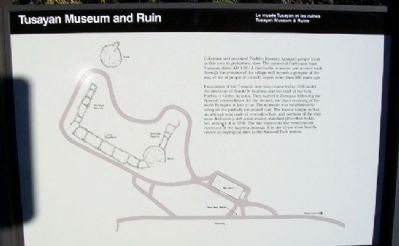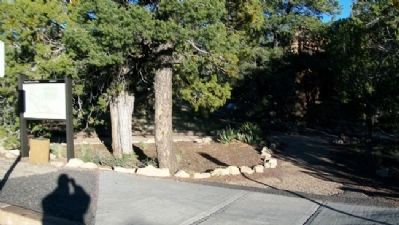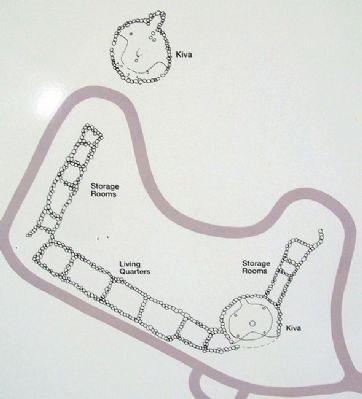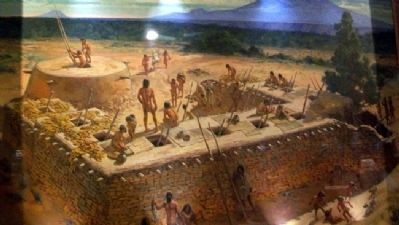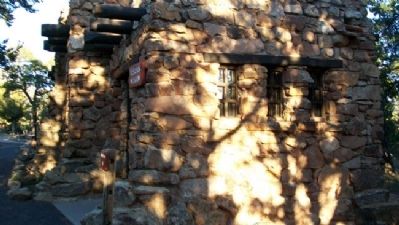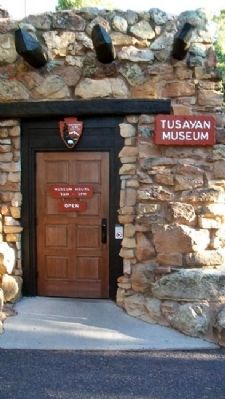Grand Canyon National Park in Coconino County, Arizona — The American Mountains (Southwest)
Tusayan Museum and Ruin
Cohonina and ancestral Pueblo (Kayenta Anasazi) people lived in this area in prehistoric time. The ancestral Puebloans built Tusayan about AD 1185. A visit to the museum and a short walk through the remains of the village will furnish a glimpse of the way of life of people at Grand Canyon more than 800 years ago.
Excavation of the Tusayan ruin was conducted in 1930 under the direction of Harold S. Gladwin and the staff of the Gila Pueblo of Globe, Arizona. They named it Tusayan following the Spanish nomenclature for the district; the exact meaning of the word Tusayan is lost to us. The museum was established to interpret the partially-excavated ruin. The ruin is unique in that no attempt was made at reconstruction, and portions of the ruin were deliberately left unexcavated - standard procedure today, but unheard of in 1930. The site represents the westernmost extension of the Kayenta Anasazi. It is one of the most heavily visited archeological sites in the National Park system.
Erected by National Park Service, U.S. Department of the Interior.
Topics. This historical marker is listed in these topic lists: Anthropology & Archaeology • Native Americans • Settlements & Settlers.
Location. 36° 0.786′ N, 111° 51.982′ W. Marker is in Grand Canyon National Park, Arizona, in Coconino County. Marker is between the parking lot and museum, southeast off Desert View (South Rim) Drive (Arizona Highway 64). Touch for map. Marker is in this post office area: Grand Canyon AZ 86023, United States of America. Touch for directions.
Other nearby markers. At least 8 other markers are within 7 miles of this marker, measured as the crow flies. Tusayan Ruin Trail (within shouting distance of this marker); Ancient Illusion (approx. 3.1 miles away); 1956 Grand Canyon TWA-United Airlines Aviation Accident Site (approx. 3.1 miles away); The Watchtower (approx. 3.1 miles away); Tragedy Remembered (approx. 3.1 miles away); Spanish Discovery (approx. 3.3 miles away); Grandview, 1898 (approx. 6.9 miles away); Mining on Horseshoe Mesa (approx. 6.9 miles away). Touch for a list and map of all markers in Grand Canyon National Park.
Also see . . .
1. Tusayan Ruin Pamphlet. National Park Service PDF (Submitted on January 10, 2011, by William Fischer, Jr. of Scranton, Pennsylvania.)
2. Grand Canyon Archeological Resources. National Park Service website entry (Submitted on January 10, 2011, by William Fischer, Jr. of Scranton, Pennsylvania.)
3. Desert View Drive. National Park Service website entry (Submitted on January 10, 2011, by William Fischer, Jr. of Scranton, Pennsylvania.)
Credits. This page was last revised on April 22, 2024. It was originally submitted on January 10, 2011, by William Fischer, Jr. of Scranton, Pennsylvania. This page has been viewed 1,111 times since then and 38 times this year. Photos: 1, 2, 3, 4, 5, 6. submitted on January 10, 2011, by William Fischer, Jr. of Scranton, Pennsylvania.
